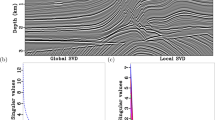Abstract
The ratios between frequency components of evoked otoacoustic emissions (OAE) were investigated for 100 ears. The signals were decomposed by means of an adaptive approximation method into basic waveforms coming from a very large and redundant dictionary of Gabor functions. The high time-frequency resolution of the method and the parametric representation of the waveforms allowed for an estimation of the frequency ratios of the basic components. A repetitive occurrence of the “fifths”, “fourths” and octaves connected with the Pythagorean temperament was found. The octaves containing “fifths” were identified. This kind of sequences in OAE tend to appear in the same form for tonal stimulations of different frequencies and for broadband stimuli. The significance of the results was confirmed by comparison to Monte Carlo simulations of the null hypothesis of random distribution of frequency modes. These findings support the resonance theory of hearing, which binds musical ratios with the geometrical spacing of outer hair cells in the cochlea.
Similar content being viewed by others
References
Bell A (2002) Musical ratios in geometrical spacing of outer hair cells in colchea: strings of an underwater piano? In: Stevens C, Burnham D, Mc pherson G, Schubert E, Renwick J (eds) Proceedings of the International Conference on Music Perception and Copgnition, Sydney http://mimosa1.incubator.uiuc.edu/ jba/PAPERS/AndrewBell/ Bell ICMPC7.pdf
Bell A, Fletcher NH, (2004) The cochlear amplifier as a standing wave: “Squirting” waves between rows of outer hair cells?. J Acoust Soc Am 116: 1016–1024
Braun M (1997) Frequency spacing of multiple spontaneous otoacoustic emissions. Hear Res 114: 197–203
Durka PJ, Ircha D, Blinowska KJ (2001) Stochastic time-frequency dictionaries for Matching Pursuit. IEEE Trans Signal Process 49(3): 507–510
Jedrzejczak WW, Blinowska KJ, Konopka W, Grzanka A, Durka PJ (2004) Identification of otoacoustic emission components by means of adaptive approximations. J Acoust Soc Am 115: 2148–2158
Kemp D (1978) Stimulated acoustic emissions from within the human auditory system. J Acoust Soc Am 64: 1386–1391
Lonsbury-Martin BL, Martin GK, Probst R, Coats AC (1998) Spontaneous otoacoustic emissions in a nonhuman primate. II. Cochlear anatomy. Hear Res 33: 69–93
Mallat S (1999). Awavelet tour of signal processing, 2nd edn. Academic, NewYork
Mallat SG, Zhang Z, (1993) Matching pursuit with time-frequency dictionaries. IEEE Trans Sign Process 41: 3397–3415
Neely ST, Kim DO, (1986) A model for active elements in cochlear biomechanics. J Acoust Soc Am 79: 1472–1480
Probst R, Lonsbury-Martin BL, Martin GK (1991) A review of otoacoustic emissions. J Acoust Soc Am 89: 2027–2067
Shera CA, Guinan JJ Jr (1999) Evoked otoacoustic emissions arise by two fundamentally different mechanisms: A taxonomy of mammalian OAEs. J Acoust Soc Am 105: 782–798
Talmadge CL, Tubis A, Long GR, Tong C (2000) Modeling the combined effects of basilar membrane nonlinearity and roughness on stimulus frequency otoacoustic emission fine structure. J Acoust Soc Am 108: 2911–2932
Zweig G, Shera CA (1995) The origin of periodicity in the spectrum of evoked otoacoustic emissions. J Acoust Soc Am 98: 2018–2047
Zwicker E, Fastl H (1990) Psychoacoustics, facts and models. Springer, Berlin Heidelberg, NewYork
Author information
Authors and Affiliations
Corresponding author
Rights and permissions
About this article
Cite this article
Blinowska, K.J., Jedrzejczak, W.W. & Konopka, W. Resonant modes and musical ratios in otoacoustic emissions. Biol Cybern 93, 366–372 (2005). https://doi.org/10.1007/s00422-005-0012-1
Received:
Accepted:
Published:
Issue Date:
DOI: https://doi.org/10.1007/s00422-005-0012-1




